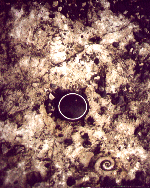The Farr Formation

The Farr Formation has been interpreted as a shallow water limestone facies (the aspect, appearance, and characteristics of a rock unit, usually reflecting the conditions of it's origin) of a transgressive sequence extending over the platform. The Farr Formation is composed of mottled dolomitic limestone of Ordovician age (A typical outcrop can be seen to your left). The dolomite is found within the many burrows found in the limestone. These borrows are of undetermined origin.
As can be seen in this close up photo  the mottling pattern is highly visible and unmistakeable. Notice how the the dolomite weathers brown while the surrounding limestone weathers gray. The dolomite weathers both positively and negativly. The entire bed is highly fossiliferous, displaying many fine fossil specimens. The mottling pattern is due to massive bioturbation of the beds. Specimens of Recepticulities, Maclurites (seen below in the lower right hand corner as the "curled" shell), Hormotoma and large Orthocones are also clearly visible.
the mottling pattern is highly visible and unmistakeable. Notice how the the dolomite weathers brown while the surrounding limestone weathers gray. The dolomite weathers both positively and negativly. The entire bed is highly fossiliferous, displaying many fine fossil specimens. The mottling pattern is due to massive bioturbation of the beds. Specimens of Recepticulities, Maclurites (seen below in the lower right hand corner as the "curled" shell), Hormotoma and large Orthocones are also clearly visible.

The lens cap in the photos are for a sense of scale. Also occuring in these beds are rugose (Streptelasma) and tabulate (Halysites) corals, stromataporoids, crinoids and crinoidal debris, several species of brachiopods and trilobite fragments. Photos of these and many more fossils from the Farr Formation are set up for your perusal in a slide show, available under the Paleontology section. Be sure to check them out!
 Thornloe Geology
Thornloe Geology
 Cobalt Geology
Cobalt Geology